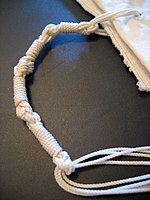
Photo from wikipedia
Although at first glance ṣiṣiṯ meet the definitional criteria of an amulet, there are just three passages in the early rabbinic literature that only indirectly suggest such an interpretation. Yet,… Click to show full abstract
Although at first glance ṣiṣiṯ meet the definitional criteria of an amulet, there are just three passages in the early rabbinic literature that only indirectly suggest such an interpretation. Yet, as it turns out, the tassels feature strong connections with the priestly clothes, and given the protective role played by the latter inside the Tabernacle, ṣiṣiṯ can be interpreted as a lay functional equivalent of the sacerdotal garment. The present paper has three main purposes: first, to scrutinize the passages from B. Men. (41a, 43b and 44a) that are often taken as witnessing to the apotropaic function of fringes; second, to contextualize tassels in the network of the priestly objects: teḵēleṯ, sa‘aṭnēz and ṣiṣ ; third, to advance a hypothesis regarding the implicit apotropaic potential of ṣiṣiṯ .
Journal Title: Review of Rabbinic Judaism
Year Published: 2018
Link to full text (if available)
Share on Social Media: Sign Up to like & get
recommendations!